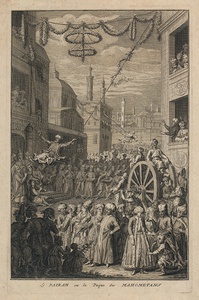| Method | Copper engraving |
| Artist | Bernard Picart |
| Published | 1743 |
| Dimensions | Image 307 x 200 mm, Plate 328 x 210 mm, Sheet 432 x 285 mm |
| Notes |
A plate depicting Bairam, a Muslim festival, from Bernard Picart's Cérémonies et coutumes religieuses de tous les peuples du monde. The scene shows a bustling street, filled with people celebrating the festival. Above the streets are two large swings, tied to the corners of the buildings. To the right is a small ferris wheel with figures seated and another figure cranking the wheel. The Bairam is a term for two Muslim festivals that take place after Ramadan. The word 'Bairam' comes from the Turkish word bayram, which refers to a national holiday or festival. Bernard Picart (1673 – 1733), was a French engraver, the son of the engraver Etienne Picart. He was born in Paris and worked in France and the Netherlands. Following the death of his wife in 1708, he moved to The Hague and later Amsterdam in 1711 where he became a Protestant convert and married again. His wife became his sales agent and had a reputation for her hard bargaining. Most of Picart's work were book-illustrations, including the Bible and Ovid. His most famous work is Cérémonies et coutumes religieuses de tous les peuples du monde. Jonathan I. Israel calls Cérémonies "an immense effort to record the religious rituals and beliefs of the world in all their diversity as objectively and authentically as possible". Israel notes also that Picart left Paris with Prosper Marchand, and collaborated on the Cérémonies with Jean-Frédéric Bernard, with a commitment to religious toleration. Picart, Marchand and Charles Levier belonged to a "radical Huguenot coterie". Condition: Some creasing to sheet corners. Some toning and foxing to sheet. |
| Framing | unmounted |
| Price | £125.00 |
| Stock ID | 53312 |

